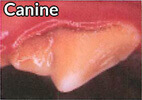Mon–Thurs: 8am–5pm
Fri–Sun: Closed
Suite 114,
Phoenix, AZ 85027-2127
Pet Dental
Dental Diseases Can Kill!
Periodontal disease is the most common clinical condition in cats and dogs even though it’s completely preventable. It’s up to you to protect your pet family by being informed and taking the necessary precautions that can save them from the slow torture caused by poor dental health.
Nearly four out of five dogs and 70% of cats over the age of three show signs of oral disease. A common cause of this is the misconception that pets with what appear to be perfectly clean, white teeth are in the clear. The truth is that what you can’t see is far more important.
Oral troubles like Periodontal Disease largely live under the surface beneath the gum line. It’s enormously important because dental disease can damage the heart, kidneys and liver if left untreated. That’s why we have put extra emphasis and care into our dental services. Keep reading to learn more about these oral problems and how to treat or prevent them.
Why is Dentistry Important for Pets
It’s simple, proper dental care for your pet will help extend its life and save them from unnecessary pain and suffering. The problem with oral issues is that they can travel and don’t like to just stay in the mouth of your fur baby. This is extremely hazardous as it can lead to far worse problems like lung disease, kidney disease and even heart disease. A little bit of TLC from us and preventative measures at home can help your pet child avoid this gloomy dental future. To help you further, we’ve loaded this page with information about the evil that can lurk in your pets mouth.
You’ll learn more about:
- What Periodontal Disease Is
- How Gum Disease Starts
- Oral Disease Symptoms
- How It’s Treated
- Why Anesthesia-Free Dental Procedures Are Harmful
- Pet Dental Disease Prevention
- The Extra Care We Take That Makes Us The Best Choice In Arizona
What Is Periodontal Disease?
Periodontal or gum disease is an inflammation of some or all of a tooth’s deep supporting structures. The condition usually starts with inflammation of a single tooth and gets worse at each of the 4 stages the disease escalates through. If left untreated, the bacteria below the gum line will secret toxins that begin to cause tissue damage and eventual tooth loss. In the final stages, your pet will have significant bone and tissue loss. Periodontal Disease includes both Gingivitis and Periodontitis.
The disease has 4 stages in its life cycle:
Stage 1
Stage or grade 1 periodontal disease presents itself as gingivitis but without separation of the gum from the tooth. There will typically be some plaque and mild gum redness.
The problem is reversible at this stage.
Stage 2
In stage or grade 2 of the disease, there will be plaque below the gum line, redness and swelling, and perhaps some loss of attachment of teeth to gums. Bone support can be reduced by up to 10 percent.
The condition is still reversible at this stage.
Stage 3
Stage or grade 3 will feature calculus (tartar) below the gum line causing from 10 to 30 percent loss of bone support, redness, swelling, bleeding and obvious gum recession. Your pet will have a significantly higher risk of jaw fractures from the bone loss.
The condition at this stage is irreversible.
Stage 4
Stage or grade 4 is marked by significant amounts of calculus below the gum line, severe inflammation, gum recession, loose and missing teeth, pus and bleeding from the gums. Bone loss will be over 30 percent. Your pet will also be at the highest risk of damage to additional organs such as liver, kidney and heart.
The condition at this stage is irreversible.








